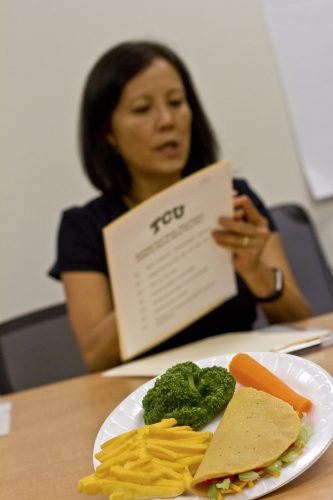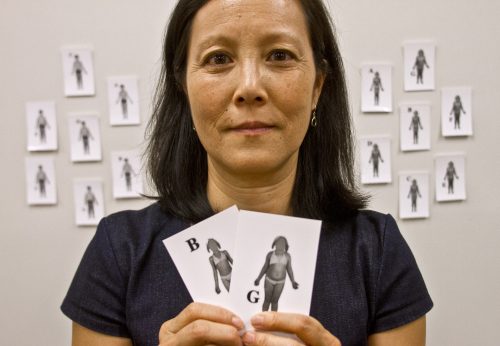Is My Child Overweight?
MyPlate and other nutritional guidelines can help parents understand childhood obesity.
Is My Child Overweight?
MyPlate and other nutritional guidelines can help parents understand childhood obesity.
American children are getting heavier and heavier. Since the 1980s, the average 11-year-old girl has gained 7 pounds without getting any taller. Boys of the same age are now about an inch taller and 13.5 pounds heavier. Yet parents tend to ignore weight issues and insist that their children fall within the normal range. This phenomenon interests Carol Howe, assistant professor of nursing in TCU’s Harris College of Nursing & Health Sciences and a certified diabetes educator.

Carol Howe uses models of various foods to illustrate appropriate portions and healthy dietary choices for children. Photo by Mark Graham
“I worked as a clinical nurse specialist for over 20 years, and most of my work was with diabetic children. So not only have I seen this myself, there is a lot of research telling us that parents underestimate their kids’ weight,” she said. “Everybody knows that happens. But the why it’s happening and what factors are related to it — these questions are up in the air.”
To probe the why, Howe teamed up with TCU colleagues Gina Alexander, associate professor of nursing, and Jada Stevenson Willis, assistant professor of nutritional sciences. The three devised a study involving data collection at the Fort Worth Museum of Science and History in fall 2016. Their findings were presented in the Journal of Pediatric Nursing in late 2017.
“We spent the better part of a year refining the study design, which needed to move children and their parents through multiple stations efficiently and separately,” Willis said. “One station was set up to collect height, weight and waist-to-hip ratio. Another station featured a wide variety of food models all arranged on the table very intentionally.”
At the fake-food table, they asked children to identify a MyPlate — the nutrition guide that replaced the U.S. Department of Agriculture’s food pyramid in 2011 — and assemble a typical meal they might eat at home.
“Not only have I seen this myself, there is a lot of research telling us that parents underestimate their kids’ weight.”
Carol Howe
Another station surveyed parents, gauging their health literacy and perceptions of their child’s weight. The sample included 160 parents and 213 children ages 7-12, 45 percent of whom were overweight or obese by Howe’s measurements.
Strikingly, 96 percent of parents underestimated on their overweight children, and 72 percent underestimated on their obese children. But when asked whether childhood obesity is a serious problem, 87 percent of parents responded yes.
“So they see it as a problem abstractly, as this societal public health concern, but they don’t view it as a problem for their own children,” Howe said.
The respondents represented a diverse societal cross-section in terms of race, gender, age and socioeconomic background. This allowed Howe to assess factors that might contribute to a misestimate. She said her team could not isolate any predictive factor, whether race, ethnicity, income, education or health literacy.
Existing literature offers little to no insight. Some studies conclude that parents of younger children underestimate their child’s weight most often, while others implicate parents of older children, Howe said. Other studies point to misperceptions by African American parents and still others to Caucasian parents. “Our takeaway was that all parents underestimate their child’s weight,” she said.
This blind-eye tendency has implications for obesity prevention, but Howe’s findings also may point to a kind of cognitive bias whereby overweight children appear normal. “I think what’s considered an acceptable weight is changing before our eyes,” she said. “We’re just used to seeing kids who are bigger. In fact, even as a nurse, I’m finding that I can’t estimate a child’s weight status accurately. Even with decades of clinical experience, I can’t eyeball a child’s weight status without doing the measurements and plotting them.”

Carol Howe uses these flash cards and asks parents to choose which card most represented their child’s weight. Parents were usually wrong. Photo by Mark Graham
Howe speculated that parents are more concerned with whether their children are happy and thriving than with their body mass index. But overweight children are at risk of developing serious health conditions — a fact, if presented the correct way, that might help parents acknowledge and address the extra pounds their children carry.
“Among nurses, I think one of our responsibilities is increasing parents’ awareness of the health consequences for children who are overweight or obese,” Howe said. “In our study, most parents could only name diabetes and heart disease as possible consequences of overweight or obesity. But they don’t really know about reproductive health problems, the association with cancer, respiratory problems and others.
“So potentially there is a learning component to address here. The number and spectrum of possible health consequences is far greater than parents realize.”

Your comments are welcome
Comments
Related reading:
Research + Discovery
Healthy Eating Marketing Campaigns May Be Ineffective
Minakshi Trivedi studies the disconnect between the public’s desire to make healthy choices and what they actually buy at the grocery store.
Research + Discovery
Childhood Poverty Can Lead to Adult Obesity
An upbringing marred by poverty and food insecurity can stay with people as they age, even manifesting as adult obesity.
Features
Food Justice Class Shines Light on Hunger, Nutrition
Community gardening, interviews and delivering nourishment to food deserts are all part of the curriculum.